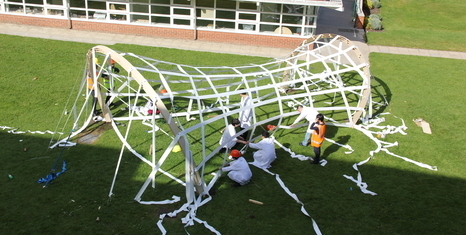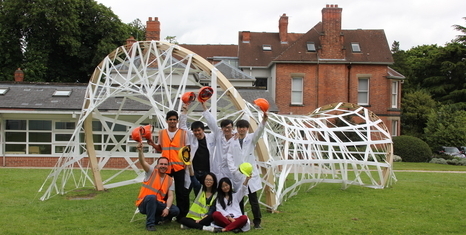A collaboration between Dr Chantelle Niblock (University of Nottingham) and Dr Carolina Rodriquez (University of Los Andes, Colombia) explored a hybrid approach to Conventional Studio and Virtual Design Studio (VDS) learning environments. Case studies of collaborative academic projects between the two universities were used to validate the approach and a research article, published in the British Journal of Educational Technology, reports on lessons learnt from these collaborative learning experiences, reflecting on contemporary cross-cultural design practiced today.
View the Collaborative Learning article online
Industrial Partners: SIOEN Industries NV and North East Timber Trade Association
Year: 2015

The ceremony of the End of Year Show 2015.
Summary:
In 2015 the University of Nottingham, Department of Architecture and Built Environment commissioned a new pavilion for the End of Year Show. The main objective was to commemorate the 50th Anniversary of the department with a pavilion designed and built by the staff and students, and able to offer an insight into the annual teaching activity.
The pavilion was designed by Paolo Beccarelli (University of Nottingham) and Dr John Harding (Visiting Tutor from Ramboll) and backed by the Architecture, Culture and Tectonics Research Group (Prof. John Chilton) and supported by a team of technical staff and volunteers from the Department of Architecture and Built Environment and eleven students from the MArch Space Enclosure Studio.
The design was based on the extensive use of commercial 3D computer graphics and computer-aided design software (Rhino3D) combined with modern plug-ins for the parametric design based on a visual programming language (Grasshopper). The shape and the details of the pavilion were optimised in order to minimize the complexity of the manufacturing, the amount of material used and the health and safety risks.
Based on two timber arches and a grid of fabric strips arranged in a saddle shaped surface, the pavilion measures 12m in length and 3.5m in height. Twenty-three strips 150mm wide and 2440mm long were cut from 6.5mm plywood (Russian birch) and assembled into two lightweight arches having a radius of 2.75m and 1.90m respectively. The final curvature was achieved by bending the laths within the elastic range of the timber and connecting three layers of plywood with two courses of shear blocks placed at an average distance of 500mm.
The membrane grid is a catenoid minimal surface between the two rigid arches modelled using Rhino Grasshopper. The cutting pattern, 11 strips in the longitudinal direction and 8 strips in the transverse direction, was calculated using a simple script, which generates a spreadsheet with the length of the strips and distances between the nodes. Finally, the main orthogonal grid (strip 100mm wide) was stabilized by a set of diagonal fabric strips of different widths (25mm, 50mm and 100mm) connected at each node with 12mm eyelets.

Construction of the End of Year Show Pavilion 2015.
The tensile force developed by the tensile grid on the arches was counterbalanced by a set of tieback tendons arranged in a similar grid, with a flexible edge obtained using a boundary rope anchored to the ground. Resistance to wind forces is provided by the double-curved geometry and the initial pretension of the membrane which was achieved through the rotation of the arches (in the longitudinal direction) and the anchoring along the perimeter of the pavilion by means of removable anchors hammered into the ground.
Two main sponsors, SIOEN Industries NV and the North East Timber Trade Association, supported the project providing the PVC coated polyester fabric and the timber for the construction.
SIOEN Industries NV cooperated actively with the University of Nottingham for the right fabric selection. The EASYFLUO™ Type 1 products chosen for the Pavilion skin are prestressed PES-PVC compounds with a weldable PVDF lacquering finish. SIOEN was the sponsor to the student work and supplied the necessary quantities for this project free of costs.
The pavilion was manufactured and installed by a group of eleven students in four working days and will remain on display during the summer between June and September.
Students MArch Space Enclosures Studio:
- Andika Visono Boenjamin
- Johnson Enyenihi
- Yuezong Liu
- Zaid Nachan
- Muygech Sok
- Kai Song
- Xinggang Xuan
- Yichi Zhang, Wen Zhang
- Chunhui Zheng
- Jing Zhou
Key publications:
BECCARELLI P. 2015, End Of Year Show Pavilion 2015, Tensinews, 29, pag.27.
 The team of students involved in the construction workshop.
The team of students involved in the construction workshop.